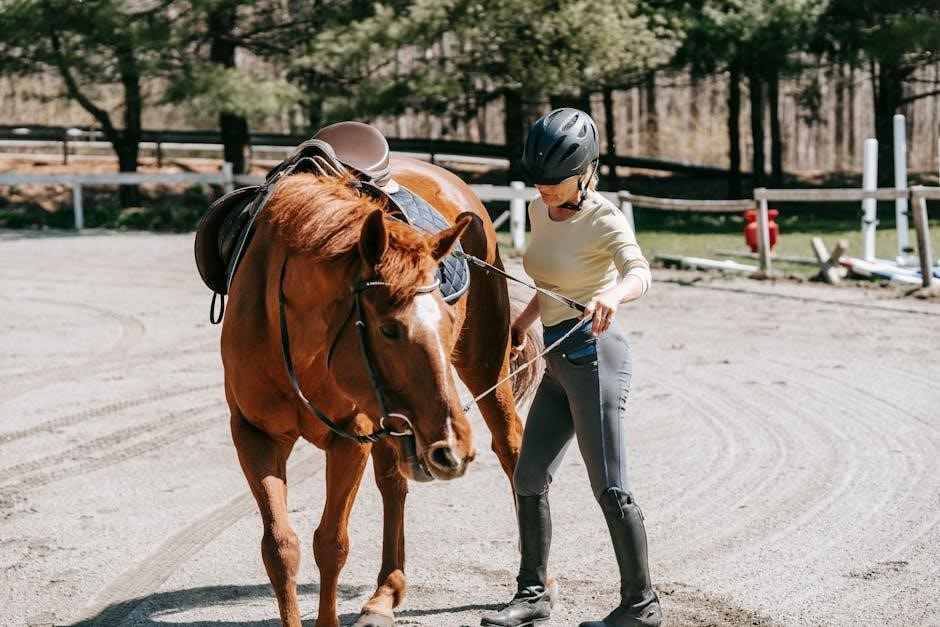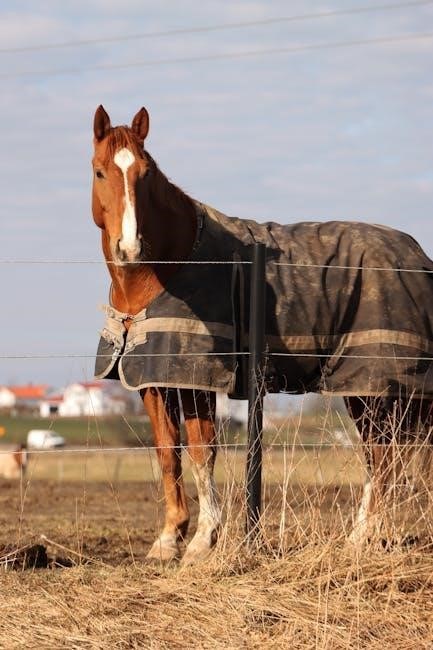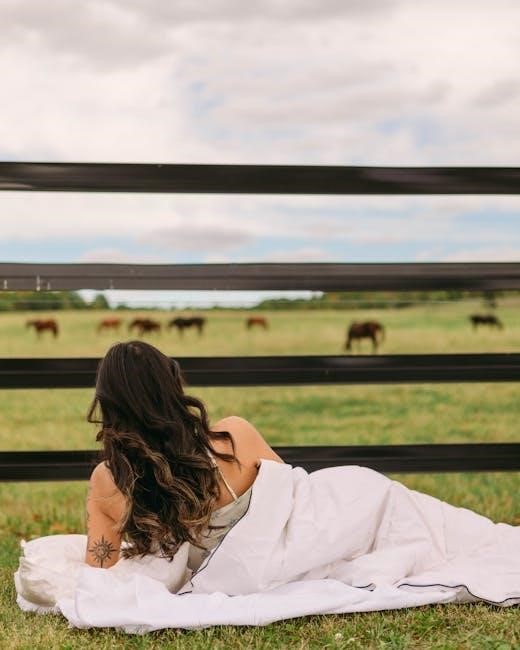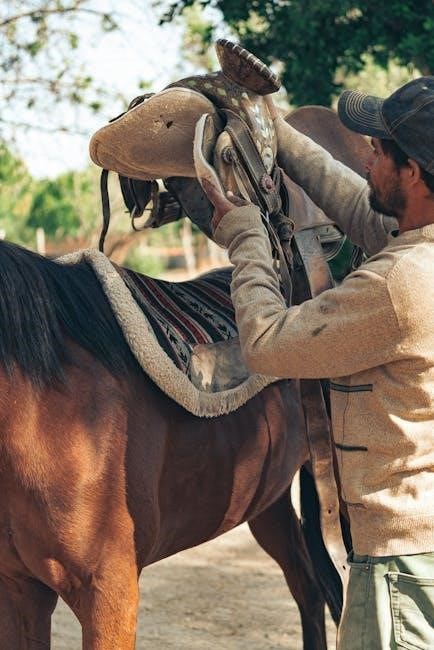Understanding the Importance of Proper Sizing
Proper sizing ensures your horse’s comfort and prevents health issues like chafing or restricted movement; A well-fitting blanket allows freedom of motion and regulates body temperature effectively‚ crucial for your horse’s overall well-being and performance throughout the year.

How to Measure Your Horse
Measuring your horse accurately is essential to ensure a proper fit for their blanket. Start by standing your horse on a flat‚ level surface and ensure they are standing squarely‚ with their head held naturally. Use a soft‚ flexible tape measure or a blanket sizing stick‚ which can be purchased at most equine supply stores.
Place the tape measure at the center of your horse’s chest‚ just below the neckline‚ and extend it diagonally to the point of the rump‚ just below the tail. This measurement will give you the blanket size in inches. It’s important to keep the tape measure snug but not tight‚ as this can lead to an inaccurate reading.
For consistent results‚ always measure your horse in the same spot and under the same conditions. If your horse is particularly muscular or has a stocky build‚ you may need to consider a slightly larger size. Additionally‚ some breeds‚ such as draft horses‚ may require specialized sizing due to their larger frames.
Double-check your measurements to avoid errors‚ as an ill-fitting blanket can cause discomfort or restrict movement. If you’re unsure‚ consult a sizing chart or seek guidance from an equine professional. Accurate measuring ensures your horse stays comfortable and protected throughout the year.
Types of Horse Blankets
Horse blankets come in lightweight‚ medium‚ and heavy options‚ often waterproof for outdoor use. Turnout blankets are durable and waterproof‚ while stable blankets are softer for indoor comfort. Combo blankets include a neck cover‚ designed for full protection.
Lightweight‚ Medium‚ and Heavyweight Options
Horse blankets are available in lightweight‚ medium‚ and heavyweight options to suit different weather conditions and your horse’s needs. Lightweight blankets are ideal for spring and fall‚ providing minimal warmth without restricting movement. They are often used for horses that are sensitive to cold but do not require heavy insulation. Medium-weight blankets offer a balance‚ suitable for cooler months‚ and are a popular choice for horses that spend time both indoors and outdoors. Heavyweight blankets are designed for extreme cold‚ offering maximum warmth and protection‚ especially for horses in outdoor paddocks during winter. When selecting a blanket‚ consider your horse’s age‚ breed‚ and body condition‚ as these factors influence their ability to regulate body temperature. Proper fit is crucial to ensure comfort and prevent chafing or restricted movement. Always choose a blanket that aligns with your horse’s specific needs and the climate they are exposed to‚ ensuring their well-being and performance throughout the year.
Seasonal Considerations
Choose blankets based on the season to ensure your horse stays comfortable. Lightweight blankets are ideal for spring and fall‚ while medium and heavyweight options are best for winter. Always monitor weather changes and adjust accordingly for optimal comfort.
When to Use Different Blanket Weights
The weight of your horse blanket should be chosen based on the season and weather conditions. Lightweight blankets are ideal for spring and fall when temperatures are mild‚ providing just enough coverage without overheating your horse. Medium-weight blankets are suitable for cooler weather‚ such as early winter‚ offering warmth while still allowing mobility. Heavyweight blankets are reserved for extreme cold‚ ensuring your horse stays warm in freezing temperatures. It’s important to monitor your horse’s comfort and adjust the blanket weight as needed. Factors like wind‚ rain‚ and your horse’s individual needs‚ such as age or health conditions‚ also play a role in selecting the right weight. By rotating blankets seasonally‚ you can ensure your horse remains comfortable and healthy year-round. Always consider your horse’s specific needs and the climate in your region when deciding which blanket weight to use.

Factors Affecting Blanket Size

Age‚ breed‚ and body condition significantly influence the size of the blanket your horse needs. Younger horses‚ certain breeds‚ and those with specific body types may require adjustments for a proper fit. Ensure accurate measurements for optimal comfort and protection.
Age‚ Breed‚ and Body Condition
Age‚ breed‚ and body condition play crucial roles in determining the right horse blanket size. Young horses‚ such as foals‚ may require smaller blankets due to their smaller stature‚ while older horses might need a more tailored fit to accommodate any physical changes. Breeds also vary significantly; for instance‚ draft horses are larger and may need extra-large blankets‚ whereas Arabians or ponies typically require smaller sizes. Body condition‚ such as muscle tone or weight‚ further influences fit. Horses with a leaner build may need a slightly larger blanket to ensure comfort‚ while those with a stockier build might require a more snug fit to prevent excess fabric from causing irritation. Proper sizing ensures the blanket distributes weight evenly and allows for natural movement. Consider consulting size charts specific to your horse’s breed and age for an accurate fit. Additionally‚ regular monitoring of your horse’s body condition can help adjust blanket size as needed over time. Always aim for a balance that prioritizes comfort‚ mobility‚ and effective coverage to protect your horse from the elements.

Common Mistakes to Avoid
Common mistakes include incorrect measurements and poor fit. Ensure the blanket isn’t too tight or too loose‚ as this can cause discomfort or restricted movement. Always double-check sizing charts and consider your horse’s unique shape and size.
Incorrect Measurements and Poor Fit
Incorrect measurements are a common issue when selecting horse blankets. Measuring improperly can lead to a blanket that is either too tight‚ restricting movement‚ or too loose‚ causing it to shift and rub against the horse’s skin. A poor fit can result in discomfort‚ skin irritation‚ or even behavioral issues. To avoid this‚ always use a soft‚ flexible measuring tape and ensure the horse is standing naturally with its legs square. Measure from the center of the chest‚ along the side‚ to the point of the horse’s rump‚ just below the tail; Avoid pulling the tape too tight or leaving it too slack‚ as this can skew the measurement. Additionally‚ consider the horse’s age‚ breed‚ and body condition‚ as these factors can influence sizing. Using a sizing chart specific to the manufacturer is crucial‚ as sizes can vary between brands. Double-checking measurements and consulting with a professional if unsure can help ensure the best fit for your horse.
Proper sizing is key to your horse’s comfort and health. Always measure carefully‚ consider seasonal needs‚ and choose blankets that fit well to ensure your horse stays comfortable and protected throughout the year.
Final Tips for Choosing the Right Blanket
When selecting the ideal blanket for your horse‚ prioritize proper fit and comfort. Always measure your horse accurately‚ considering factors like age‚ breed‚ and body condition. Opt for high-quality materials that breathe well and durable stitching. Consider your local climate to determine the appropriate weight of the blanket. For instance‚ lightweight blankets are perfect for milder weather‚ while heavy-duty options are essential for harsh winters. Additionally‚ think about your horse’s specific needs‚ such as neck coverage or belly bands‚ to ensure full protection. Regularly inspect the blanket for wear and tear to maintain its effectiveness. By combining careful measurement‚ seasonal appropriateness‚ and attention to detail‚ you can ensure your horse stays comfortable and well-protected all year round. Remember‚ a well-fitted blanket not only enhances your horse’s well-being but also supports their performance and overall health.
